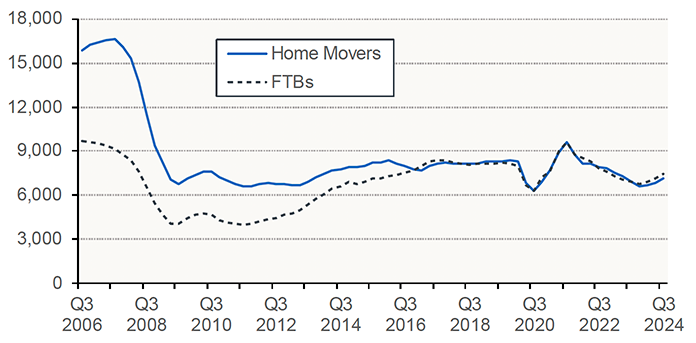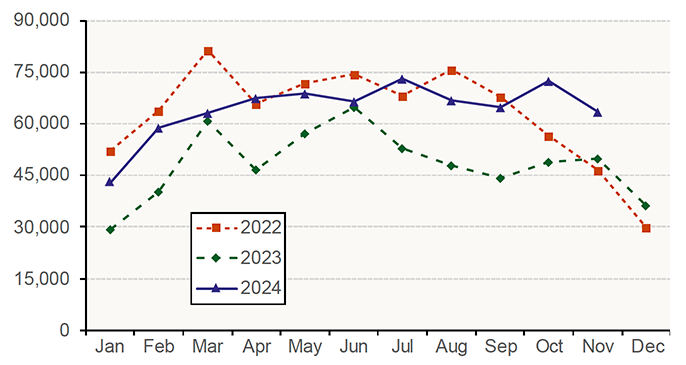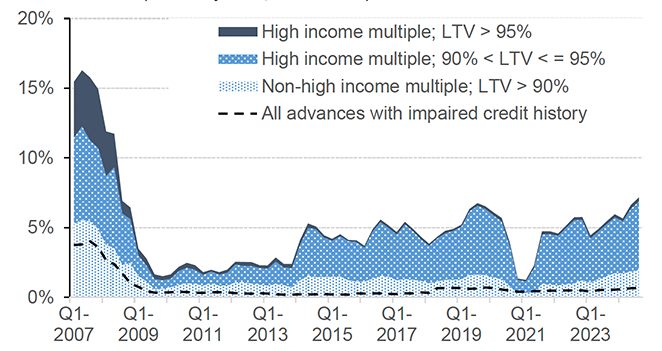Scottish Housing Market Review Q4 2024
Quarterly bulletin collating a range of previously published statistics on the latest trends in the Scottish housing market.
5. Mortgage Approvals and LTVs
5.1. New Mortgage Advances
There were 8,760 new mortgages advanced to first-time buyers in Scotland in Q3 2024, an annual increase of 17.1%. Meanwhile, there were 8,510 new mortgages advanced to home movers in Scotland in Q3 2024, an annual increase of 16.9%.
From a longer-term perspective, the number of mortgages advanced to all buyers over the first three quarters of the calendar year in 2024 (45,060) was higher than the corresponding period in 2023 (40,090) but lower than 2022 (46,470) and 2021 (53,460). This increase in mortgage lending may in part be due to the stabilisation of mortgage rates in recent months (see Section 6).

Source: UK Finance
5.2. Mortgage Approvals
Chart 5.2 plots the monthly number of mortgage approvals across the UK for house purchase by individuals. Mortgage approvals for house purchase, which are the firm offers of lenders to advance credit fully secured on dwellings by a first-charge mortgage, are a leading indicator of mortgage sales as they reflect activity early in the buying process.
The mortgage approvals data shows that over the 11-month period to November 2024, approvals were 31% higher than the corresponding period in 2023, but approvals for the latest year were 2.1% lower than the level recorded in the 11-months to November 2022 (Source: Bank of England).

Source: Bank of England
5.3. Loan-to-Value (LTV) Ratios
Chart 5.3 shows that after initially falling following the covid pandemic, mean LTV ratios on new mortgages advanced to both first-time buyers and home movers in Scotland recovered to their pre-pandemic levels, before declining again as the upward trend in interest rates beginning at the end of 2021 fed through to mortgage lending.
However, the mean LTV ratio for first-time buyers has now recovered to 82.4% in Q3 2024, up slightly from 82.3% in Q2 2024 and only one percentage point below its recent peak of 83.4% in Q2 2022. In contrast, the mean ratio for home movers, which fell slightly from 69.4% in Q2 2024 to 69.3% in Q3 2024, remains 3.5 percentage points below its recent peak of 72.7% in Q2 2022. (Source: UK Finance).

Source: UK Finance
In Q3 2024 the share of all regulated residential lending across the UK with an LTV greater than 90% rose by 0.5 percentage points to 7.2%, its highest level since Q2 2008, prior to the impact of the 2008 financial crisis. The share of all lending with both an LTV greater than 90% and a high income multiple increased by 0.4 percentage points to 5.2%, which is also the highest level for this series since Q2 2008. This recovery in higher-risk lending will have contributed to the increase in the mean LTV ratio for first-time buyers in Scotland discussed above. However, lending with both an LTV greater than 95% and a high-income multiple remains limited – its share in Q3 2024 was 0.3% compared with a pre-financial crisis peak of 4.5% in Q3 2007.

Source: FCA. Higher-risk lending is classified by the FCA as an LTV over 90% or an income multiple greater than or equal to 3.5 for single-income purchasers or 2.75 for joint-income purchasers.
After a small drop during October 2024, when the total number of residential mortgage products fell from 6,645 on 1 October to 6,402 on 1 November, there has been a recovery over the next two months, with the total number of products standing at 6,508 on 1 January 2025. This is only slightly lower than the 6,658 products available on 1 July 2024, which was a more-than-15-year high. The number of products with maximum LTV of 95%, at 366 on 1 January 2025, is at its highest level since 2022, and only a little below its pre-pandemic peak of just over 400. (Source: Moneyfacts UK Mortgage Trends Treasury Reports)
Mortgage shelf life is the length of time between the launch of a product and its repricing or withdrawal from the market, and average shelf life is an indicator of volatility in the mortgage market. The average mortgage product shelf life in January 2025 was 21 days, which was also its level in three of the preceding four months. This suggests a degree of stability in the market, although it is below the average of 32 days since 2011. (Source: Moneyfacts UK Mortgage Trends Treasury Reports)
Following small declines over the past two months, buy-to-let (BTL) product numbers increased to 3,321 on 1 January 2025, the highest level in two and a half years. (Source: Moneyfacts UK Mortgage Trends Treasury Reports)
Contact
Email: jake.forsyth@gov.scot
There is a problem
Thanks for your feedback